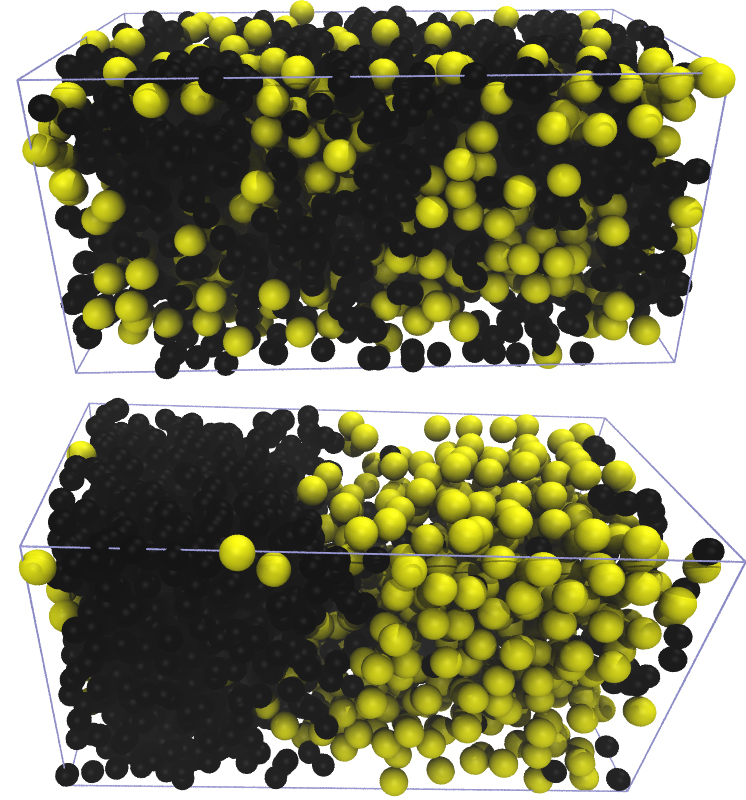Active particles may enhance phase separation

Snapshots from a molecular dynamics simulation with 547 colloids and 1,781 polymers in an elongated simulation box. The upper image shows an equilibrium configuration of the passive system which did not phase-separate. The lower image is the corresponding active system in its steady state which is clearly phase-separated. In both pictures, colloids are shown in yellow and polymers in black. (ill./©: Peter Virnau, JGU)
Systems containing self-propelling particles, such as bacteria or artificial colloidal particles, are always out of equilibrium but may show interesting transitions between different states, reminiscent of phase transitions in Systems containing self-propelling particles, such as bacteria or artificial colloidal particles, are always out of equilibrium but may show interesting transitions between different states, reminiscent of phase transitions in equilibrium.
However, application of analytical and computational methodologies from equilibrium statistical mechanics is questionable to study properties of such active systems. An international team of researchers – including Dr. Peter Virnau and Professor Kurt Binder of Johannes Gutenberg University Mainz (JGU), Benjamin Trefz of the JGU Graduate School of Excellence “Materials Science in Mainz” (MAINZ), and scientists from India and the U.S. – has studied the phase separation of a mixture of active and passive particles via molecular dynamics simulations and integral equation theoretical calculations. The distinctive feature of the model used is that the “activity” of the particles is tunable, containing passive particles as a limiting case for which already phase separation occurs.
“Our research results demonstrate that the introduction of activity may not only hamper phase separation as shown previously, but can enhance it as well, based on the coordination among the active particles,” explained Dr. Peter Virnau of the Institute of Physics at Mainz University. Moreover, the researchers provided an approximate mapping of the phase behavior and structural properties of this nonequilibrium problem onto an equilibrium problem. A general validity of this mapping is subject to further careful testing. The confirmation of such validity would be an important step forward in understanding properties of active matter.
Publication:
Subir K. Das et al.
Phase Behavior of Active Swimmers in Depletants: Molecular Dynamics and Integral Equation Theory
Physical Review Letters, 15 May 2014
DOI: 10.1103/PhysRevLett.112.198301
http://journals.aps.org/prl/abstract/10.1103/PhysRevLett.112.198301
Further information:
Dr. Peter Virnau
Condensed Matter Theory Group (KOMET)
Institute of Physics
Johannes Gutenberg University Mainz (JGU)
D 55099 Mainz, GERMANY
phone +49 6131 39-20493
fax +49 6131 39-20496
e-mail: virnau@uni-mainz.de
http://www.komet331.physik.uni-mainz.de/virnau.php
http://journals.aps.org/prl/abstract/10.1103/PhysRevLett.112.198301 – Abstract
Media Contact
All latest news from the category: Physics and Astronomy
This area deals with the fundamental laws and building blocks of nature and how they interact, the properties and the behavior of matter, and research into space and time and their structures.
innovations-report provides in-depth reports and articles on subjects such as astrophysics, laser technologies, nuclear, quantum, particle and solid-state physics, nanotechnologies, planetary research and findings (Mars, Venus) and developments related to the Hubble Telescope.
Newest articles

Recovering phosphorus from sewage sludge ash
Chemical and heat treatment of sewage sludge can recover phosphorus in a process that could help address the problem of diminishing supplies of phosphorus ores. Valuable supplies of phosphorus could…

Efficient, sustainable and cost-effective hybrid energy storage system for modern power grids
EU project HyFlow: Over three years of research, the consortium of the EU project HyFlow has successfully developed a highly efficient, sustainable, and cost-effective hybrid energy storage system (HESS) that…

After 25 years, researchers uncover genetic cause of rare neurological disease
Some families call it a trial of faith. Others just call it a curse. The progressive neurological disease known as spinocerebellar ataxia 4 (SCA4) is a rare condition, but its…





















